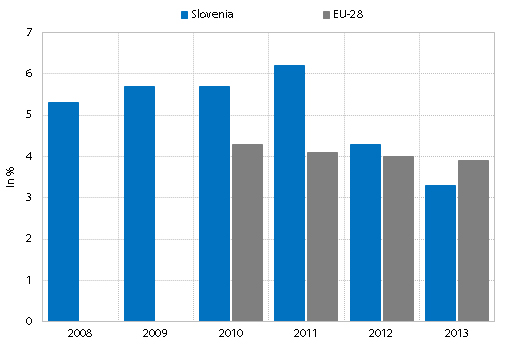MATERIAL WELL-BEING - Housing
The indicator Housing deprivation rate (in view of the number of deprivation items) is the percentage of persons living in dwellings without two out of four housing deprivation items, i.e. bad dwelling conditions, dwelling without a bath or a shower, dwelling without an indoor flushing toilet, and dwelling too dark. The indicator shows housing conditions, which reflect material well-being. Growth of the housing deprivation rate has a negative impact on well-being.
Figure: Housing deprivation rate, Slovenia and the EU, 2008−2013, % of the population

Sources: Eurostat, SURS.
Note: Data for EU-28 are available only from 2010 on.
In 2013, 3.3% of people in Slovenia were deprived in at least two out of four housing deprivation items, which is much less than in 2012 (4.3%). For people whose income is above the at-risk-of-poverty threshold, the rate was 2.7% and for people whose income is below the at-risk-of-poverty threshold the rate was much higher (7.1%). The most common reason for deprivation was bad dwelling conditions. In 2013 housing conditions in Slovenia were slightly better than in the EU overall (3.9%), while in the previous years they were slightly worse.
Results of supplementary indicators show:
In 2013, 15.6% of the population in Slovenia was living in dwellings with not enough rooms regarding the number of household members (EU: 17.3%)*. Compared to 2012, the overcrowding rate in Slovenia declined, whereas in the EU overall it went up. The overcrowding rate shows that the quality of living, measured with the number of rooms per household member, in Slovenia is slightly better than in the EU overall.
In Slovenia, the housing cost overburden rate (share of persons living in households where housing costs exceed 40% of disposable household income) was 6.0% of the population in 2013 (2012: 5.2%) and has been increasing since the onset of the economic crisis, which is a result of higher housing costs and simultaneous decline of disposable income. In Slovenia the share of people overburdened by housing costs is half the EU average (11.0%), which is partly a result of the higher share of the population living in owner occupied houses and flats.
* Due to changes in the methodology in 2011, the data from 2011 on are not comparable with the data for the previous years.
